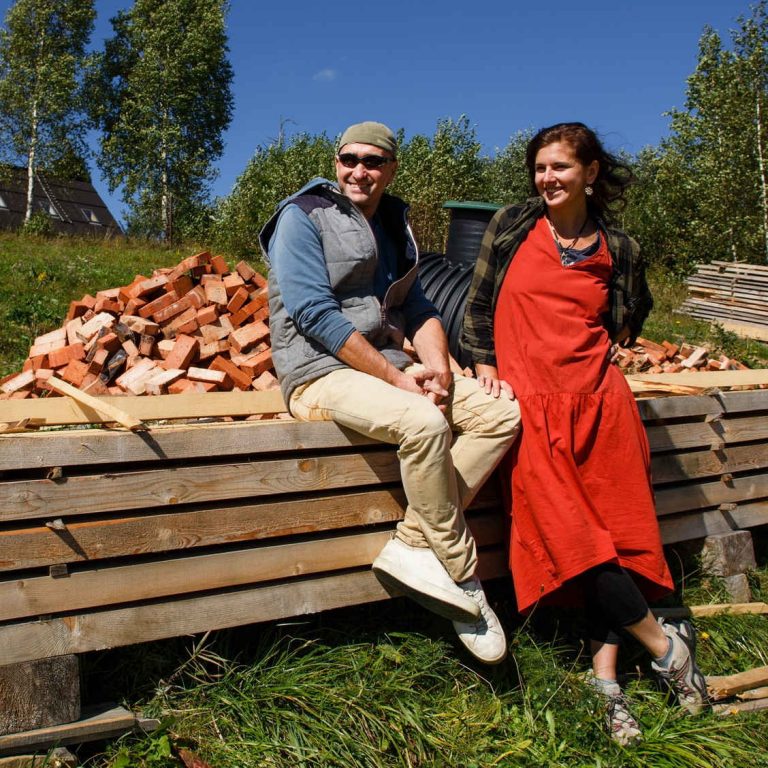The Carpathian village of Slavske, located in the valley of the Opir river and surrounded by mountains, has been a resort since the beginning of the 19th century, when it saw the construction of its first hotel and climatotherapy station. By 1980, ski lifts and sport schools had opened, and the area became popular among winter sport and active living enthusiasts.
But as Slavske continues to grow and change, it begins to affect the world around it: clearing forests, building cabins, and polluting the area with construction. Instead, Eduard Pastykh and Olha Sukha, married architects from Lviv, believe, this hotspot should take an alternative approach to expansion, for which they suggest the green building experiments.
First skis
The first trip to Slavske is a sort of initiation for the people native to the Halychyna region, the couple told us. They come to see the incredible, picturesque landscapes, face mountains for the first time and try delicious home-made dishes, cooked by locals:
— The first skiis are such a romantic memory; almost every citizen of Lviv experiences this initiation — usually within the first few years of higher education. Winter is absolutely beautiful here: sunlight, snow and sparkling firs. Those searching for harmony and beauty adore this place. And for the youth, this is the time for first loves, parties, and getting away from home. Slavske is a real hotspot for the people of Lviv, as far as I know. Everyone has been here at least once. You’re surrounded by skis, old ladies with varenyky (dumplings), and enormous traditional brick stoves. It was always a great time; these recollections warm our hearts — and it’s the same for today’s students. The place hasn’t changed in twenty years: you’ll see the same old ladies from decades ago, the same lift attendants, and the same dangerous trails.
Olha and Eduard say that Slavske has that unique charm that continues to bring people back. They don’t want extensive construction to turn the resort into another Bukovel. Slavske has its own charisma, it’s own laws, and there’s no need to change them. Those who are looking for something different, they say, can go to the Alps.

First steps in green building
The first buildings made of eco-materials with the use of green technologies appeared through the United States in the 1970s. Back then, the goal was to demonstrate the benefits and efficiency of such structures.
These were the years when the popularity of the environmental movement was beginning to grow globally, attracting more and more American architects and ecologists. Thanks to this growing interest, fuel prices spiked. This in turn, impacted the evolution of green technologies, their purpose becoming to decrease the consumption of energy, materials, and other resources throughout the entire life cycle of a structure: its construction, use, renovation, and demolition.

From the end of 1970s to the beginning of 1990s, architects focused primarily on the search for more energy-efficient processes. As a result, we reduced our energy consumption by recycling water and harnessing natural light with the use of new technology like solar panels.
These green processes were intended to reduce humanity’s negative impact on the planet, and to improve our own health by helping the environment.
In Ukraine, houses made of straw, clay, hemp, cane, wood blocks, and other natural materials are gradually becoming more popular. In addition to the construction of eco-friendly houses, there is now a wave of ecovillages being built as well (you can read more about that here: Patskanovo eco-village in Zakarpattia).
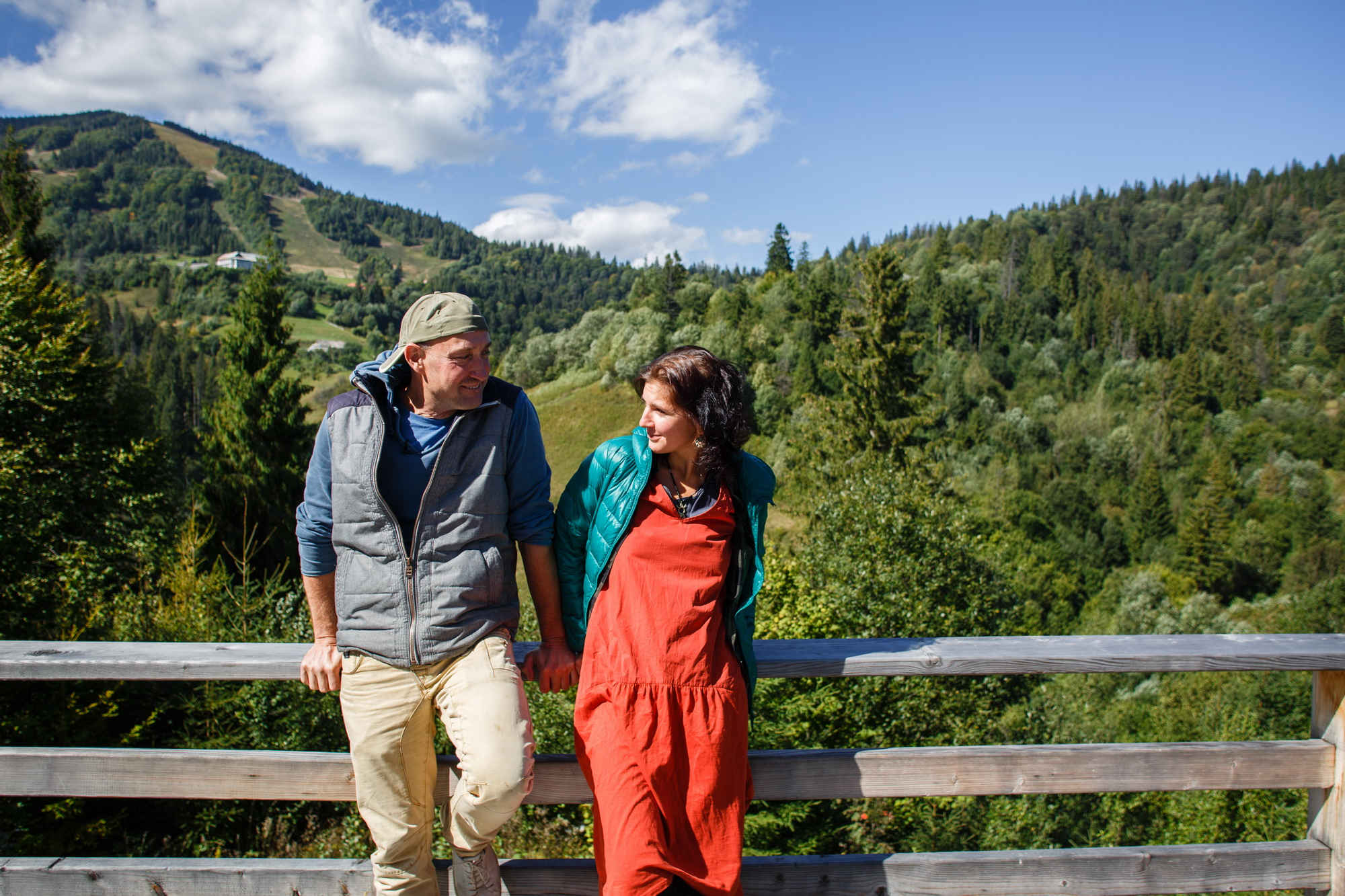
Olha and Eduard
The architects are co-founders of Creative Residence MC-6 in Slavske, a platform for creative experiments in a number of disciplines, including land art, conceptual art, photography, experimental media, and sound projects. Apart from the residential building, there are also an eco-house, “the Architect’s House”, and a farmstead called “Under Trostian”.
The couple started working with green technologies fifteen years ago; their first project was a hotel in the Carpathians. Back then, they were still designing ordinary wooden houses near Lviv and Slavske. But soon, there arose a need for a new approach to building.
— We can’t imagine our lives without construction, travelling and experimentation.
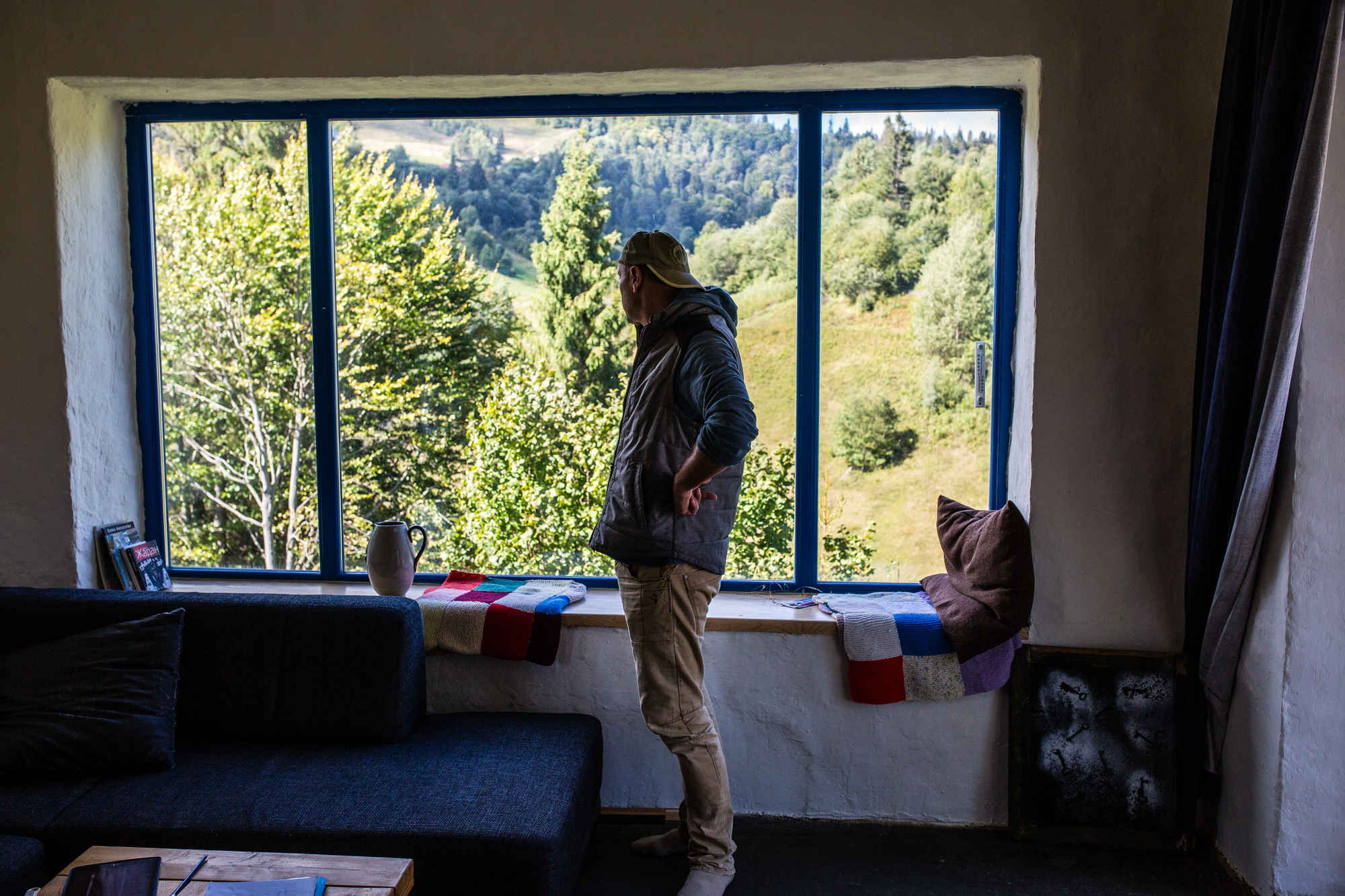
At first, Eduard found ways to use materials — particularly wood — more efficiently:
— I really feel pity for the trees. I saw how many hectares we had to cut. And then I saw how inefficiently people used the space. And really, it’s hard to call such houses ecological.
That’s where the interest towards green housing stemmed. Olha and Eduard started to explore the ecological aspects of construction and technology, gathering expertise from other countries around the world. Having travelled a lot, they had been inspired to incorporate their eco-expeditions and technologies in their own projects:
— I think everyone’s trying to find something to do with their lives, to dedicate themselves to. Those who find that something become happy. The Chinese say: find what you love to do, and you’ll never work a day again.
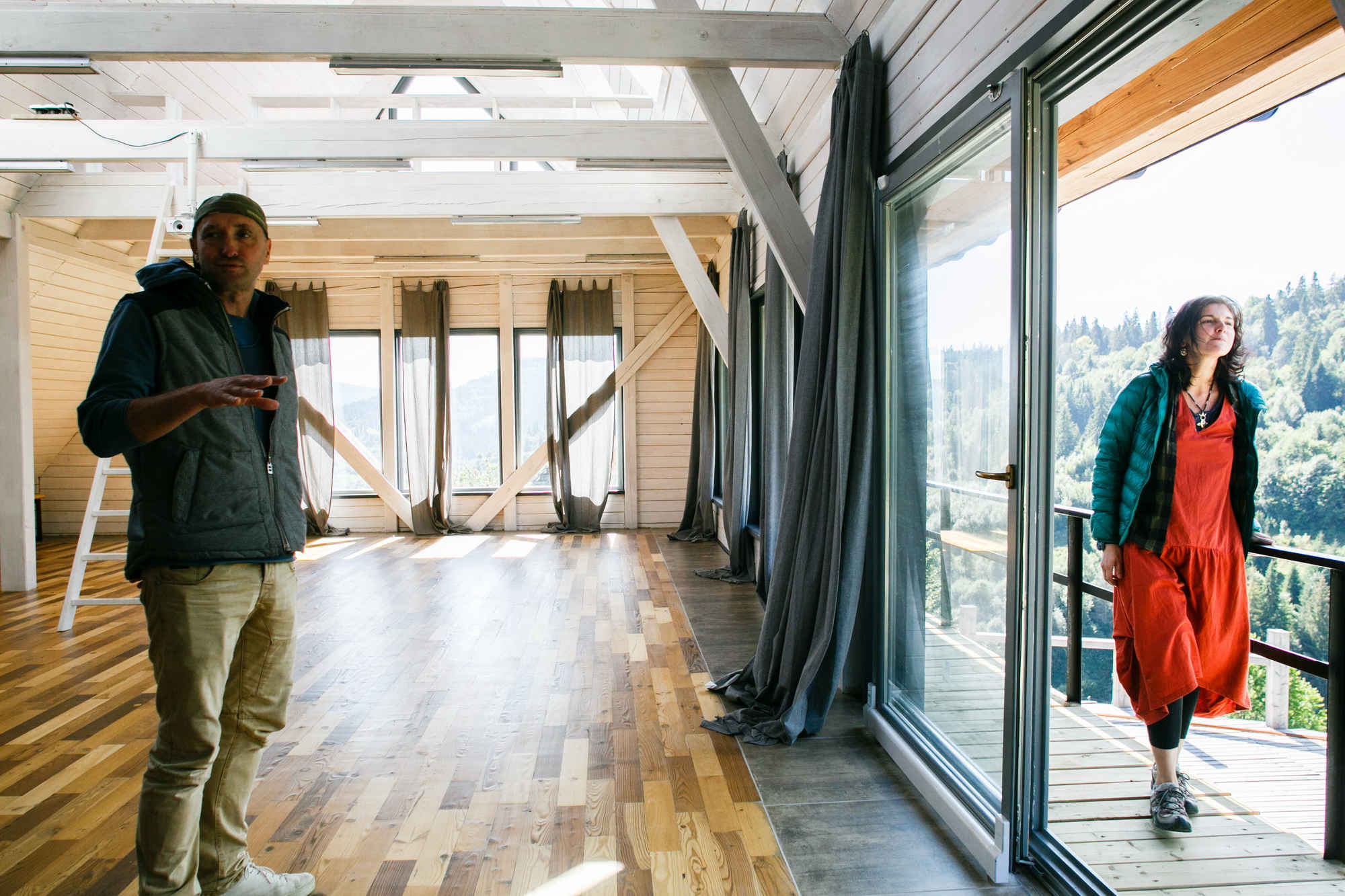
The couple embarked on their first eco-house project just after returning from their travels:
— We went on a trip to Holland, where we wrote letters to different ecological organizations across the world: Belgium, France, the Netherlands, Germany. The only response we got was from the Dutch. They invited us to visit. So we thought, “Why not?” They are so open-minded. They said, “We’ll come to Ukraine, try to teach you something new.” They first tried to show us how to press straw into a brick and work with clay to build a wall. But then we thought, this isn’t serious, what are we going to do with a piece of a wall? And that’s how we built the first cabin.
The two tell us about the Architect’s House, an eco-house where one can admire the beautiful Carpathian landscapes through massive windows:
— Here, everything is made of straw: the floors, the ceiling, the roof. The house is constructed with straw blocks; it’s like a straw cocoon. We were taught how to build it by a Dutch company.
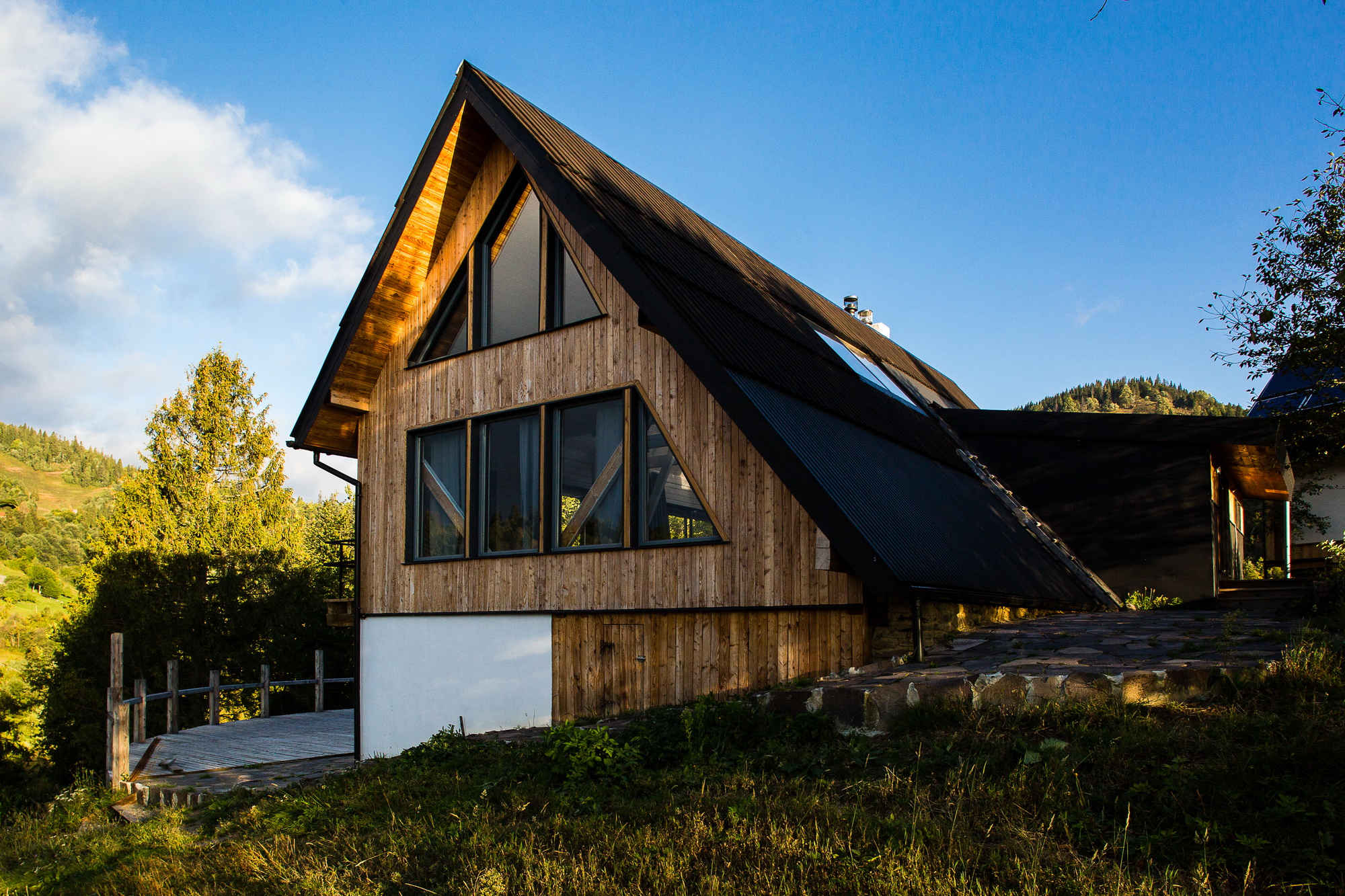
Buildings like these, with a straw skeleton, are not only safe and durable, but also very energy efficient, as the heat conductivity of straw is four times lower than that of wood, and seven times lower than brick, allowing for the reduction of cost. But no matter the material, it’s essential to ensure the proper use of technology:
— Green building is a very particular industry; it requires careful attention to details. Many try to build without considering absolutely everything, and it results in some serious accidents. For example, if you fail to properly paint a building, choosing an inappropriate paint or primer, the wall won’t be able to “breathe”, there may be stagnant effects, and the building will begin to degrade within five years. It’s very important to choose a technology that works and to use it expertly.
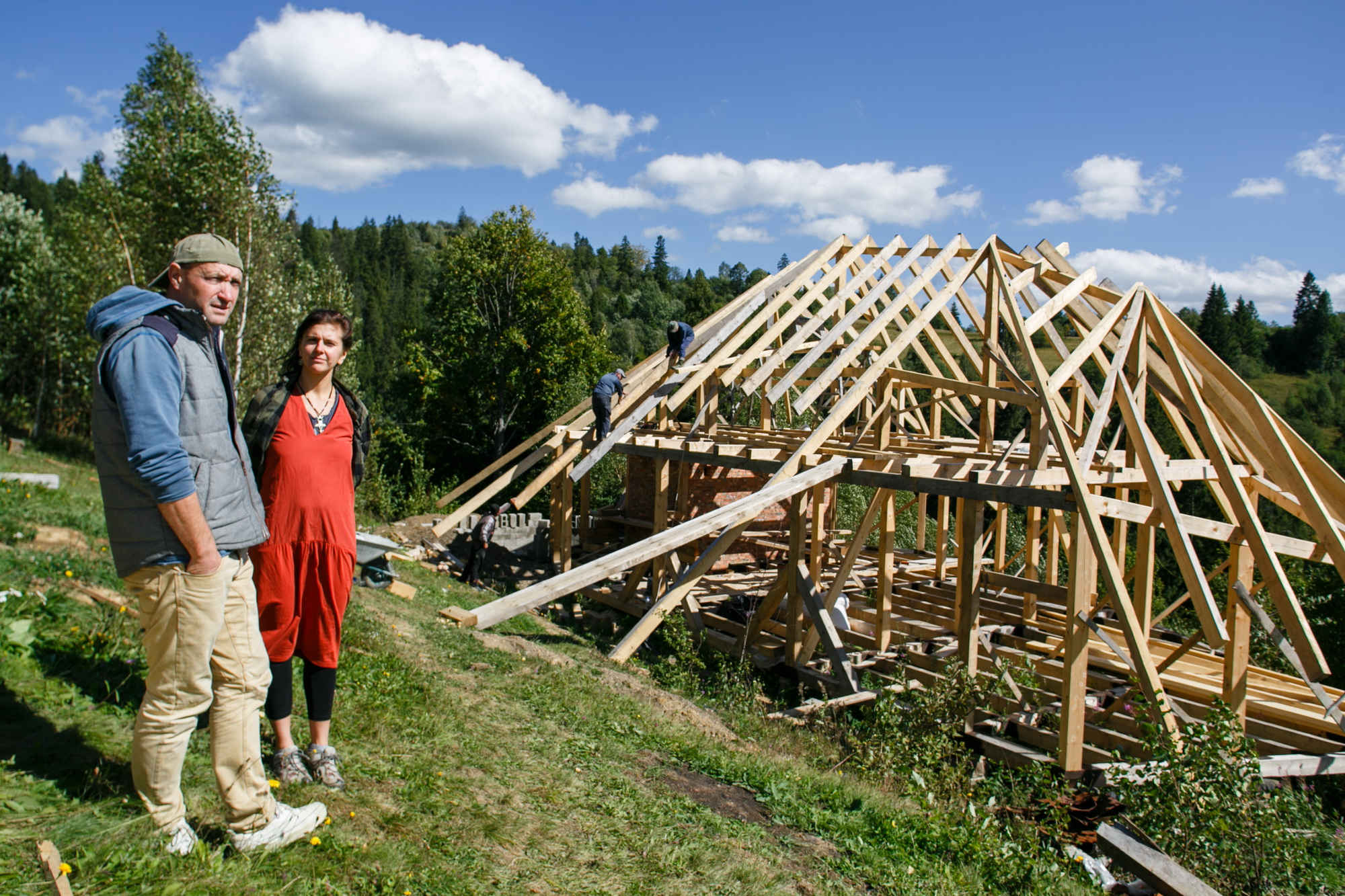
Hemp
At the site of the Architect’s House, plans have been made preparing for the construction of a building using a variety of technologies. Olha and Eduard are constantly searching for new natural materials, as they believe that sustainability means using local resources. Currently, the most popular materials are straw, hemp, petroleum, and clay:
— We’re building a house down there; it will be made of hemp residue. Right now, it’s the most interesting material, very eco-friendly and accessible. There is a technical hemp — it is tall, about four meters, and for a long time it was used to make clothes and cook food like hemp porridge, and to make hemp oil or hemp seeds. Inside the house, we also plan to use hemp materials for things like beddings. There are people today who eat hemp, wear hemp clothes, and organize seminars and festivals dedicated to hemp. Our friends make different kinds of porridges from hemp seeds. We plan to develop this area — those who are interested can come and live in the hemp house and eat the same hemp porridge that our ancestors used to eat. It’s supposed to be delicious.
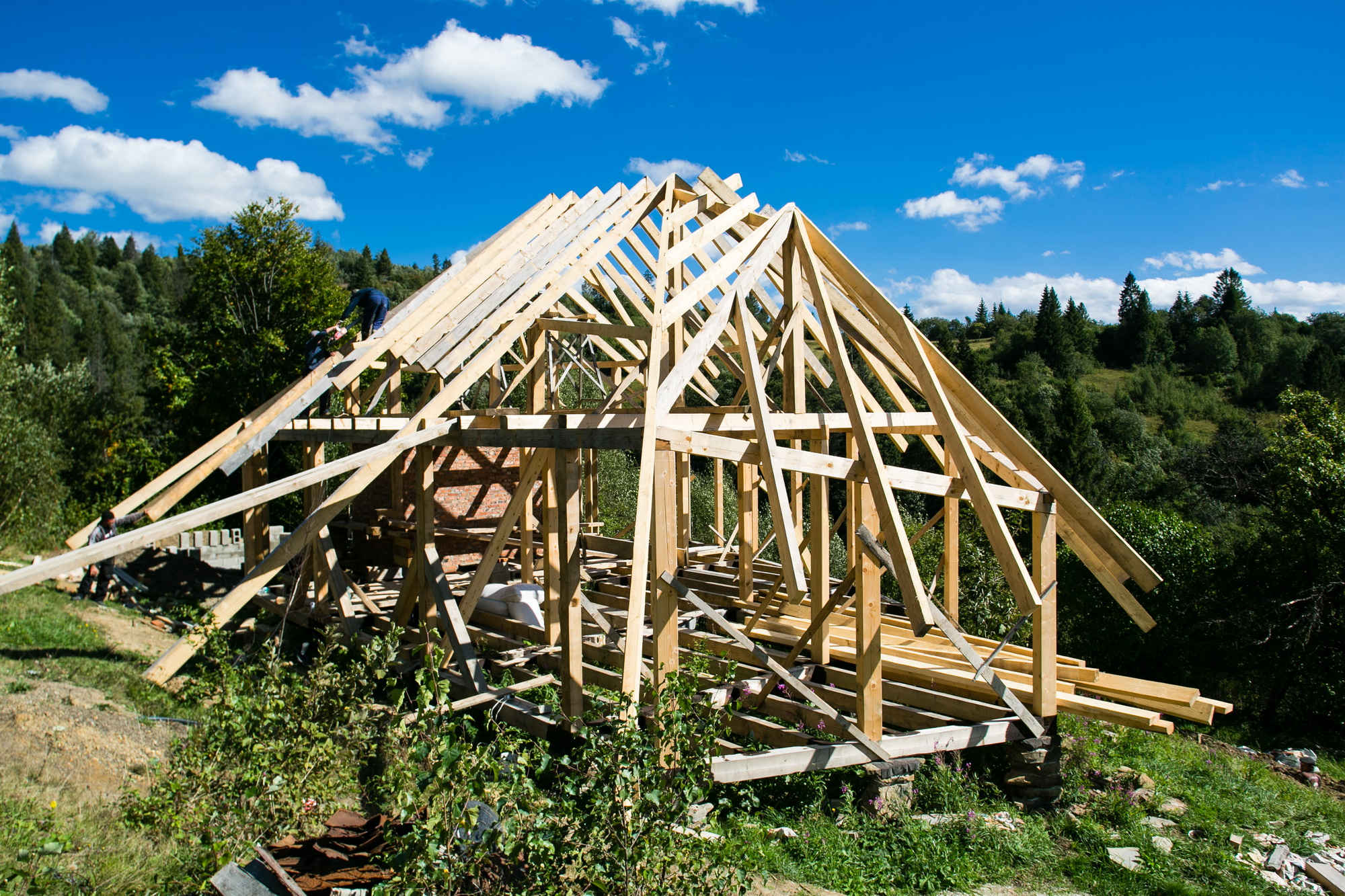
The couple says they require at least a year and a half to build the hemp house. Initially, they lay a foundation. Depending on the weather conditions, this alone may take up to two weeks. Next, a frame needs to be made, which takes several months. Then, a roof, which also requires careful work. But in the end, the amount of time needed depends on the technologies used. Eduard and Olha used shingles for the roofing on their cabin:
— The house should be autonomous. We’re making a cellar behind it, where canned food and potatoes can be stored. Pressure is used to supply spring water. The only things we need to figure out are heat and lighting. We’re going to try installing solar panels, to see how long they will work, and then we’ll add power for a stove. We want to instill a sense of connectedness with the Earth.
Before that, projects using hemp were realized by the couple in the Yavoriv District. The hemp cabin in Slavske is their third project.
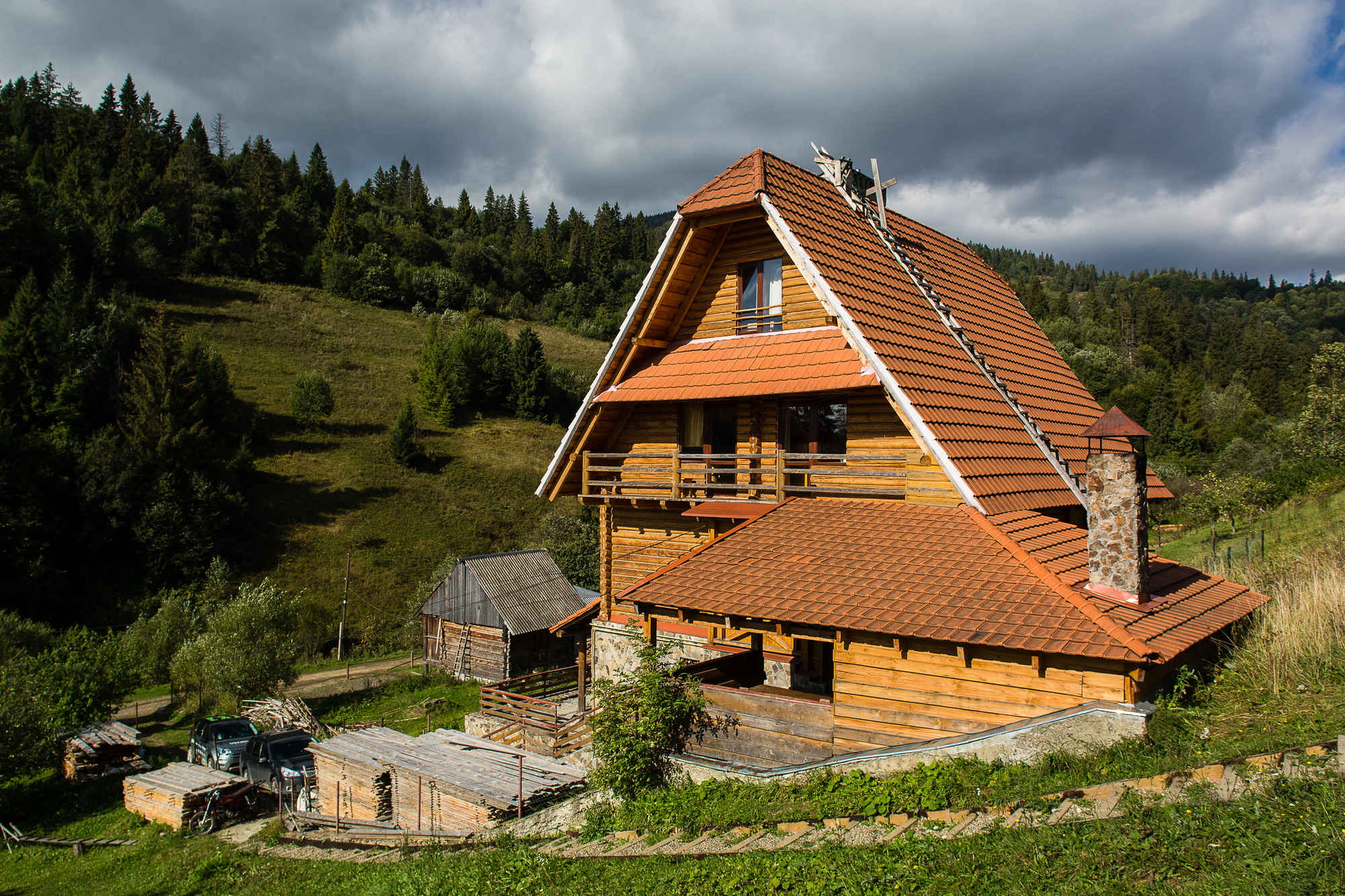
Petroleum
— When they think of petroleum, most people imagine something black with a bad smell. But in reality, there are different types of petroleum that come in different colours, and most have a very pleasant aroma. And of course, it’s a natural material, and a great opportunity to provide good air flow through the wall. The same goes for the interior: a wooden house can be covered with wax or turpentine, which are natural materials that don’t emit any hazardous or volatile substances. In such cases, the house can be called more or less environmentally-friendly.
Eduard and Olha prefer to use brown petroleum, claiming it has some advantages when compared to traditional petroleum. They say:
— Black petroleum is unpleasant visually, but brown is good for covering buildings: it is cheap, effective, and it smells good.
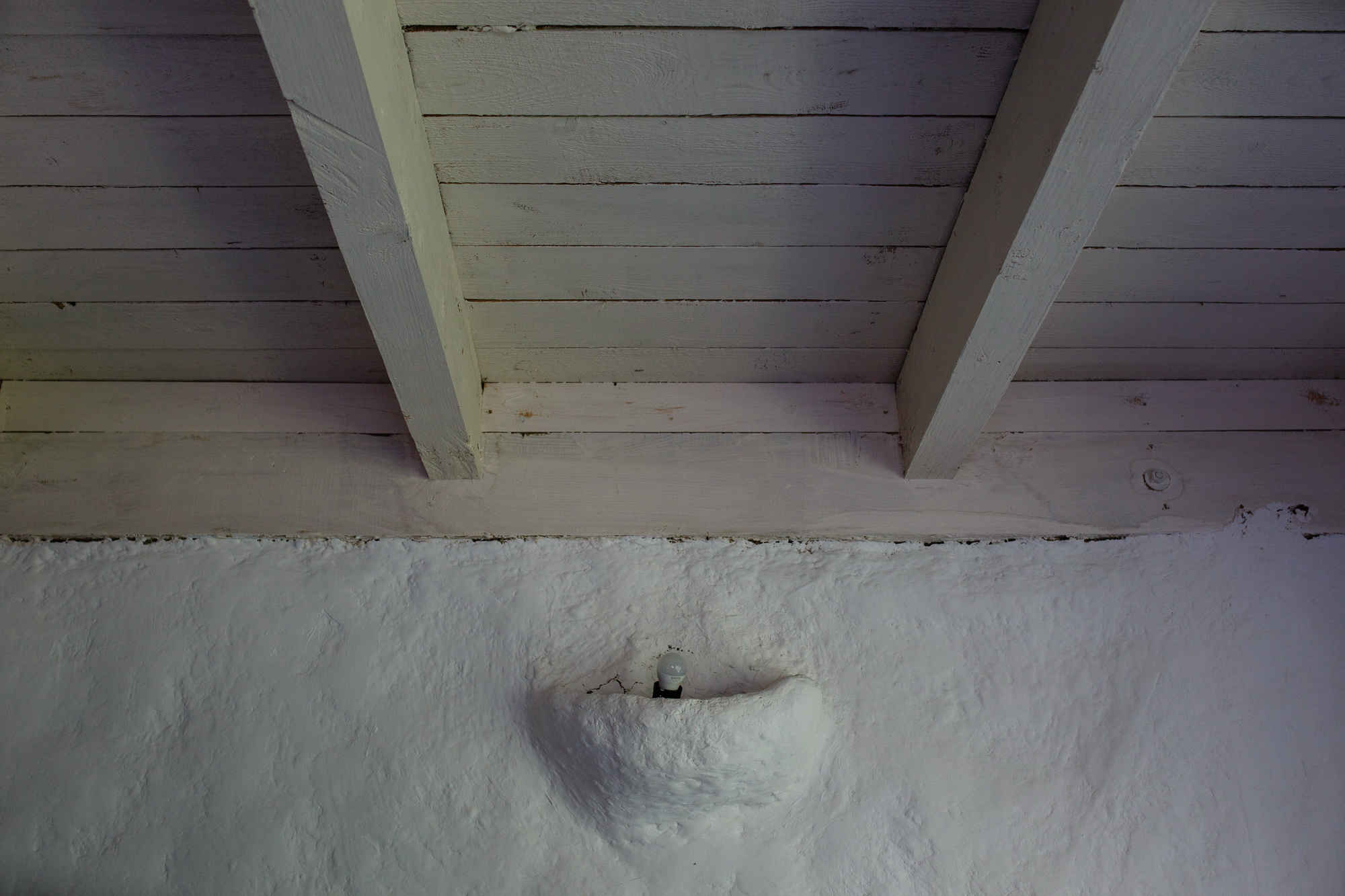
Clay
For Olha, tactual perception is very important when choosing and working with materials. She says:
— These smells are important to me. I made the floors and walls with my own hands, and mixed all the paints myself. This wall, for example, is made of mixed wax, turpentine, linseed oil and terracotta dye. It is a sort of sacred process. These floors are made of soot, clay, lime, and turpentine. It was all boiled up on this small stove, it was magic.
The architect says it’s possible to use clay for floors; it’s a simple and natural material that absorbs hazardous fumes. Clay is long-lasting and it can be recycled, so it doesn’t add to waste accumulation. With the incorporation of clay, a household can conserve heat, even with minimal fuel consumption.
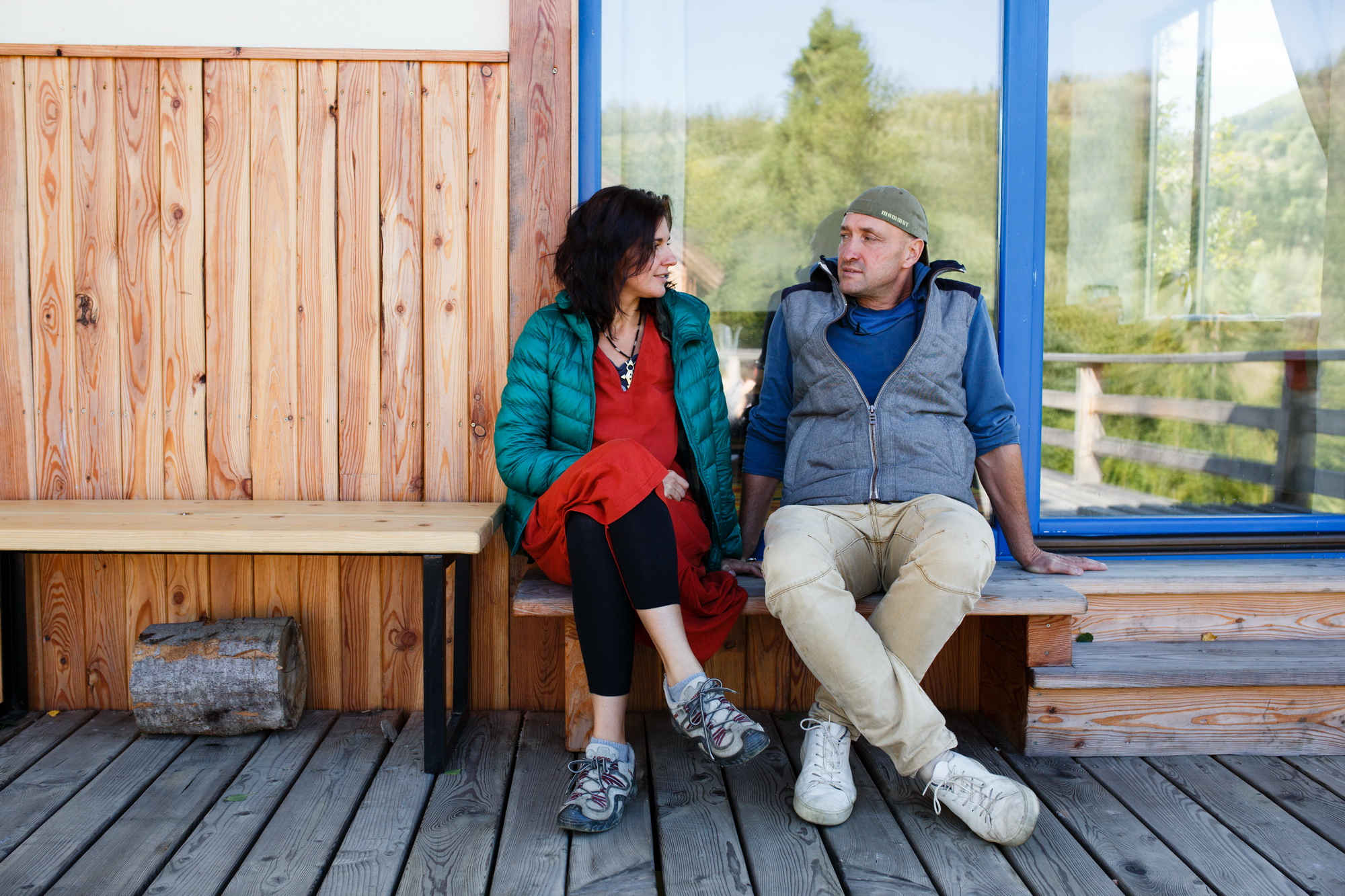
The Green Building Philosophy
In Greek, “οικία”, meaning house, is a place for people to live, and an integral part of their lives. For many centuries, a house was considered to be a sacred and special place, linking the earth and the sky, the people and the supreme forces, and assigning them their roles in the past, present and future. There is always some magic within the home that protects, rejuvenates, and connects people from different generations.
The architects say that the use of natural materials in building, which was the practice of our ancestors for many years, not only links us with our history, but also gives us the opportunity to apply old techniques to modern buildings:
— What is it all about? You can feel the magic of ancient and natural items. Many people see these buildings and say, “That’s cool, but it’s impossible to live in!” These beliefs stem from myths that these old ways are antiquated, but our idea is very simple: we want to modernize old ways, harness their spirit and apply it to the technical facilities of present-day civilization.
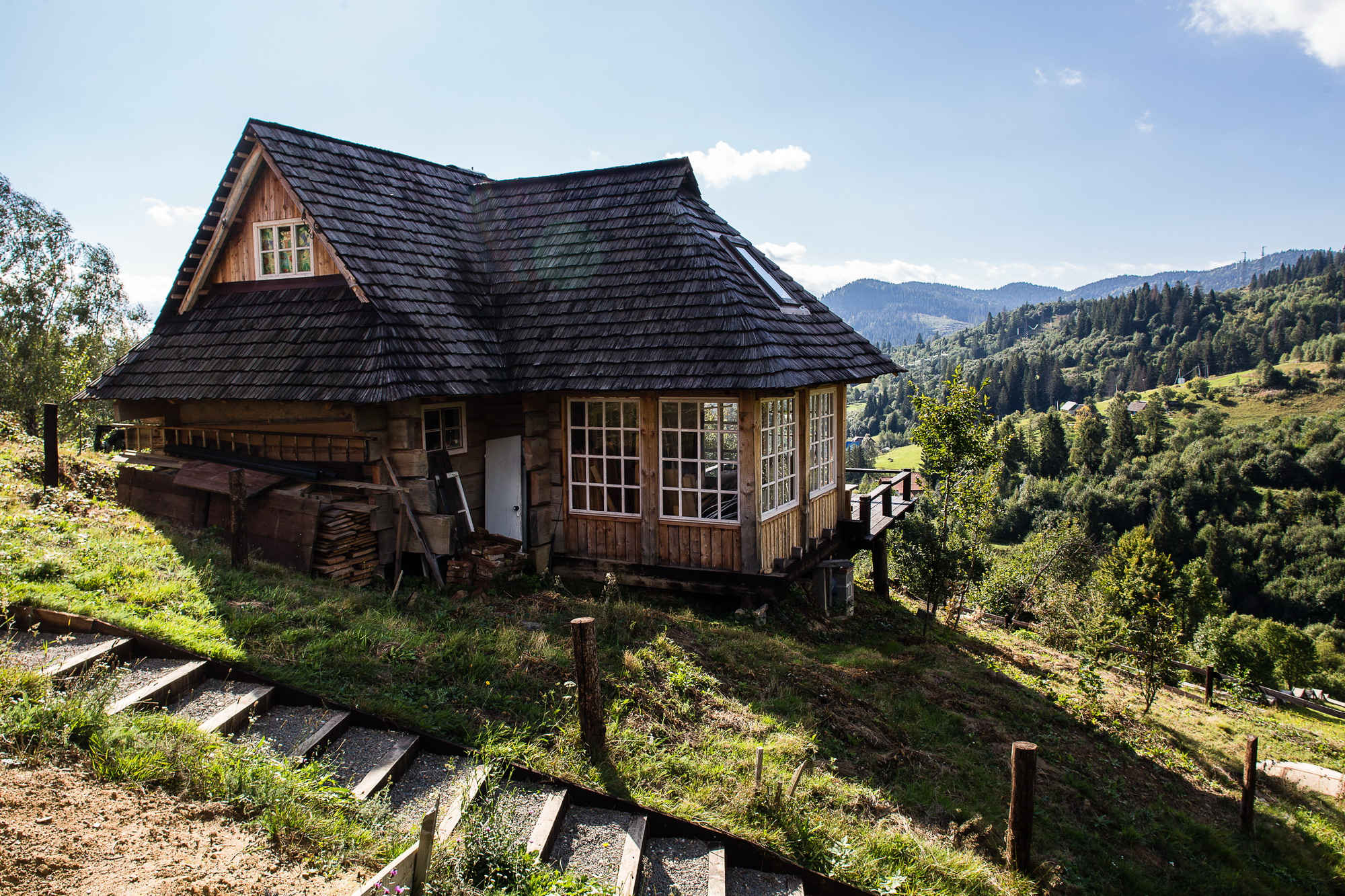
The couple tells that they listen primarily to their intuition and gut feeling when planning their projects, while taking basic laws of building into account:
— The basement is very important — it’s how we properly orient a house in space. In fact, it’s probably hardest to seat a building, even this small cabin. It was the first in the complex. We had to think about the space: where would the windows be? Is this the best place for them? This first step is very hard; it’s our biggest responsibility.
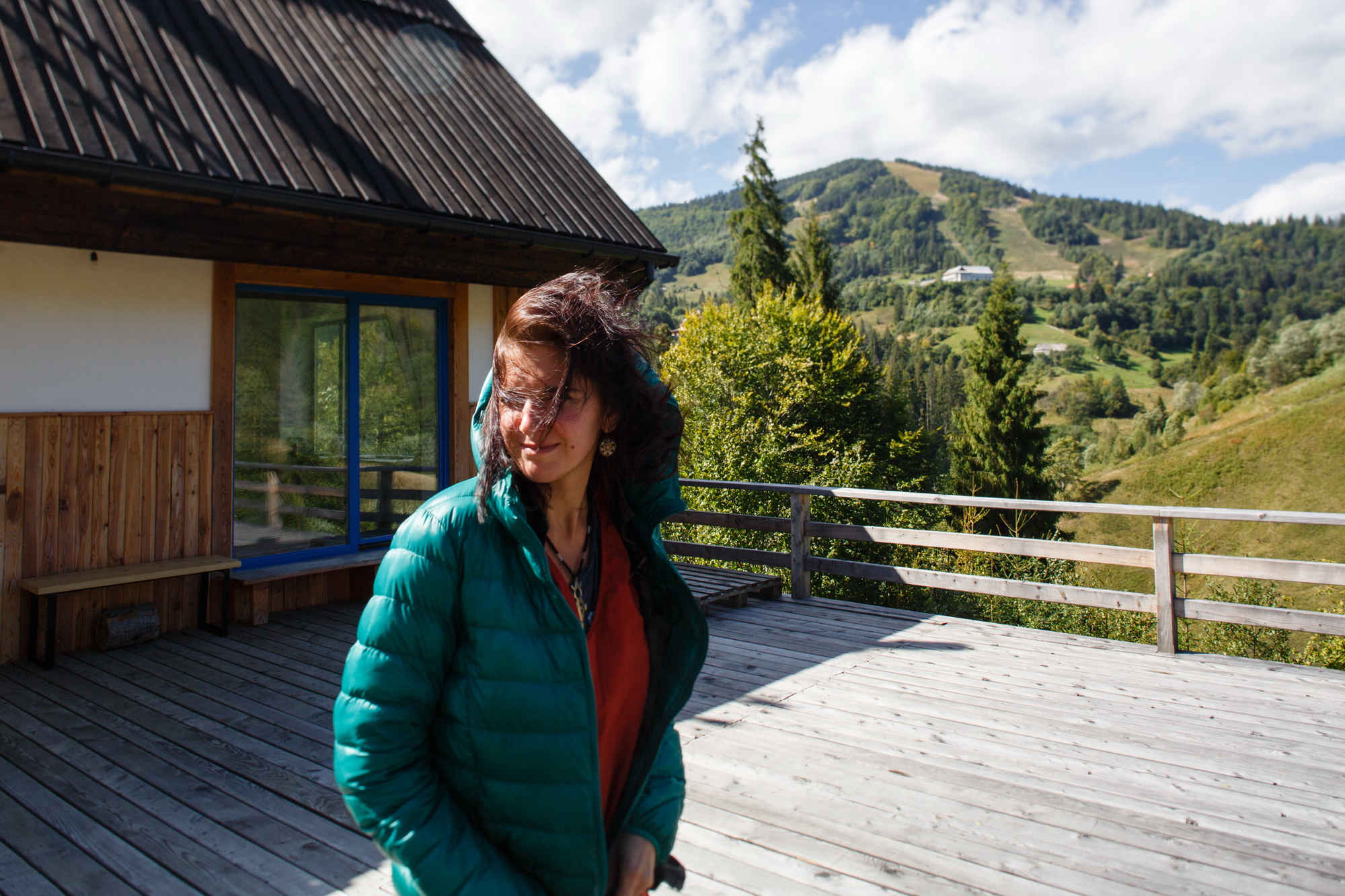
Olha tells us that natural materials have their own personalities and that one has to take this into consideration when working with them:
— I get this feeling that our building is our child. I do love its every defect. Like this unevenness. It’s almost like a bonus afterwards — but I might just be biased. Imperfection is perfect. If you start to use wood in building, you should know this wood may crack. It can also live its own life. There’s no need to get upset over it. It will perform its functions, it will be strong, it will be robust, but some things — materials in particular — should have the opportunity to live their natural cycle.
The couple invites perfectionists to come experience their homes, and to see if their approach and views suit them:
— These materials live their own lives. Everyone and everything has the right to be as it is.
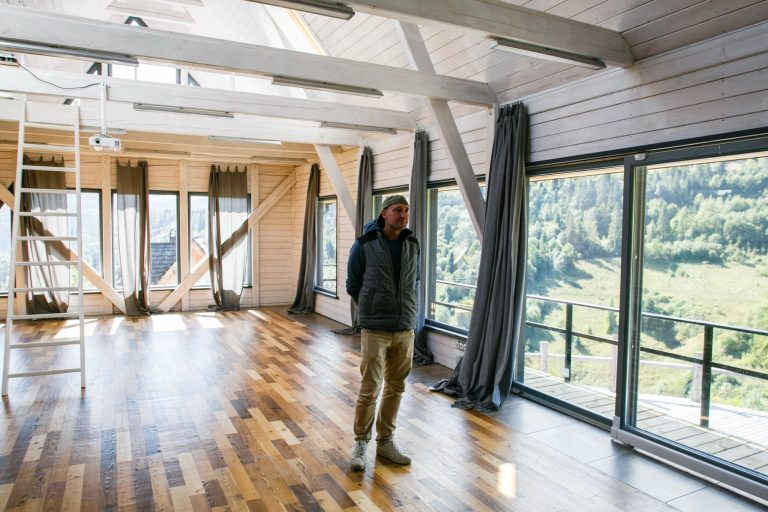
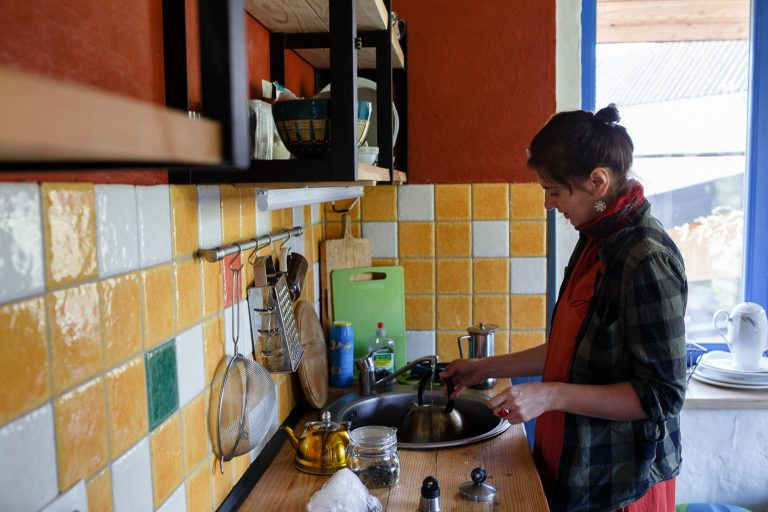
slideshow
Slavske taught Olha and Eduard how to understand people’s psyches and individual peculiarities:
— Interaction with people is very important. It’s necessary to know how to treat them well; it is the recipe for success. All people are inherently good; everyone has their own unique feature, so you can find it and use to connect with them. You need to respect people you work with, even an employee who digs holes in your yard. This isn’t as easy as it seems. But it is more cost-effective, simple and efficient, in the long run, to show respect. You should appreciate the time people spend on you and the things they do for you. There are no bad people; humans will simply treat you the same way you treat them.
For the couple, every person who takes part in the building process is important. They don’t feel that a complex project is exclusively their own; it’s a collaboration between everyone who contributed, and made an effort to progress construction.
— A lack of cooperation and sharing of ideas will never result in the realization of a project — it will forever remain a dream, the couple admits.
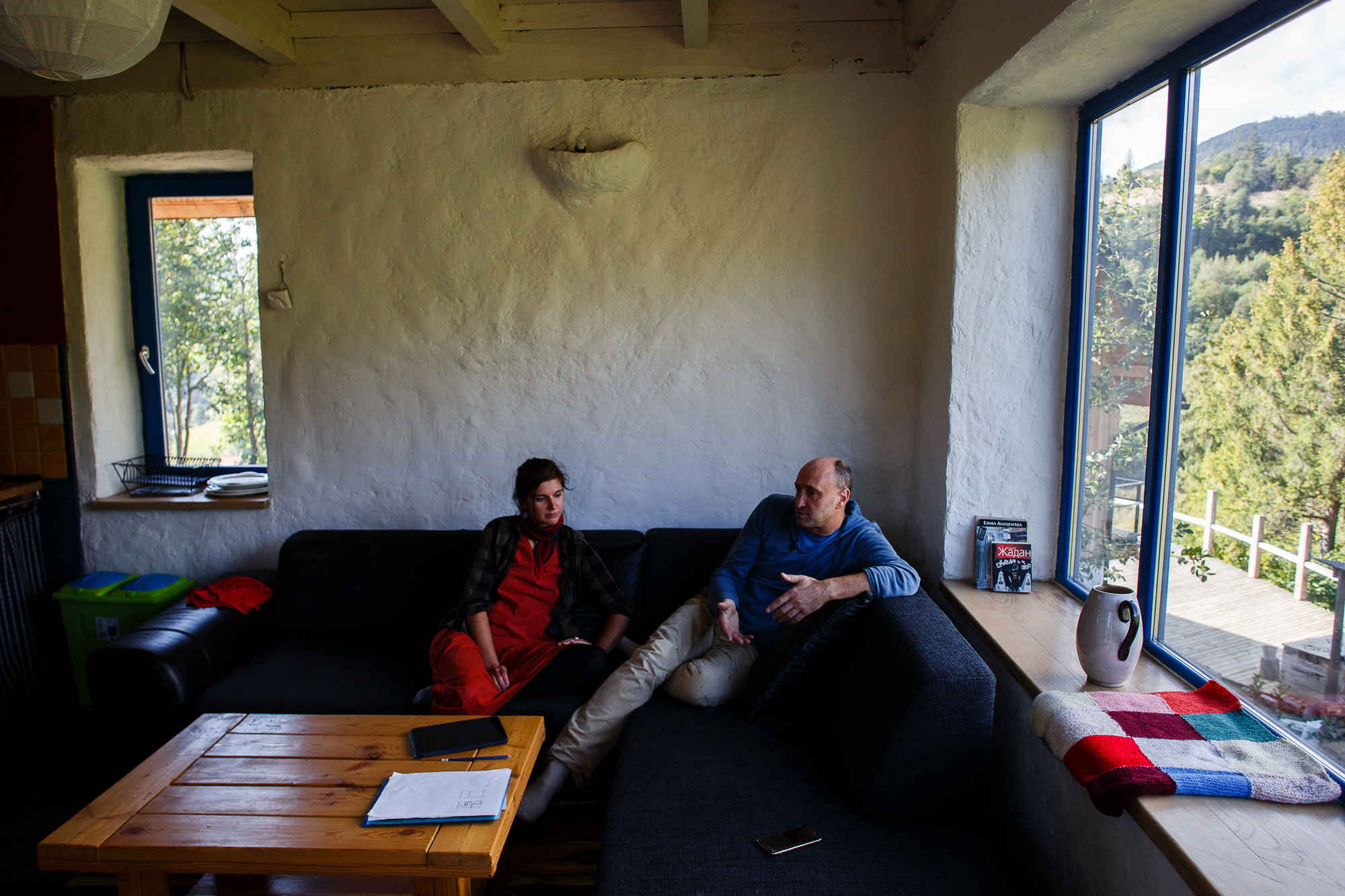
The need for information
In Ukraine, people treat the construction of ecological structures with caution. The architects say that the choice to be involved in green technologies can, in fact, be risky. Both employees and customers need to be patient to withstand the long-lasting process and to adhere to the many technological requirements:
— Why are there so few people who become part of green building? Many want to, but they change their minds after the first two attempts, as they so often face problems, especially if they hadn’t first considered all the details. First of all, it is much longer than one would expect. And people aren’t happy with how expensive and time-consuming the process is. You can browse the web, read about the technology, and think: that’s it, I know what I’m doing. But you won’t foresee the consequences — nobody speaks about them, you know? These become important issues, and the technology is no longer useful.
People have quite diverse beliefs about ecological buildings, Eduard says:
— Some think it should be very cheap while others think it must be super expensive. Really, it should average at an affordable price. A square meter of a house like this costs from USD450 to USD600. If it’s a smaller house, it will be a bit more expensive, as larger area costs less in total. These are standard and affordable prices. The only issue is that it takes longer for the house to be built, for the materials to dry, for the walls to winnow; even for the mice to eat the last grains from walls, as everyone in the chain should satisfy their needs.
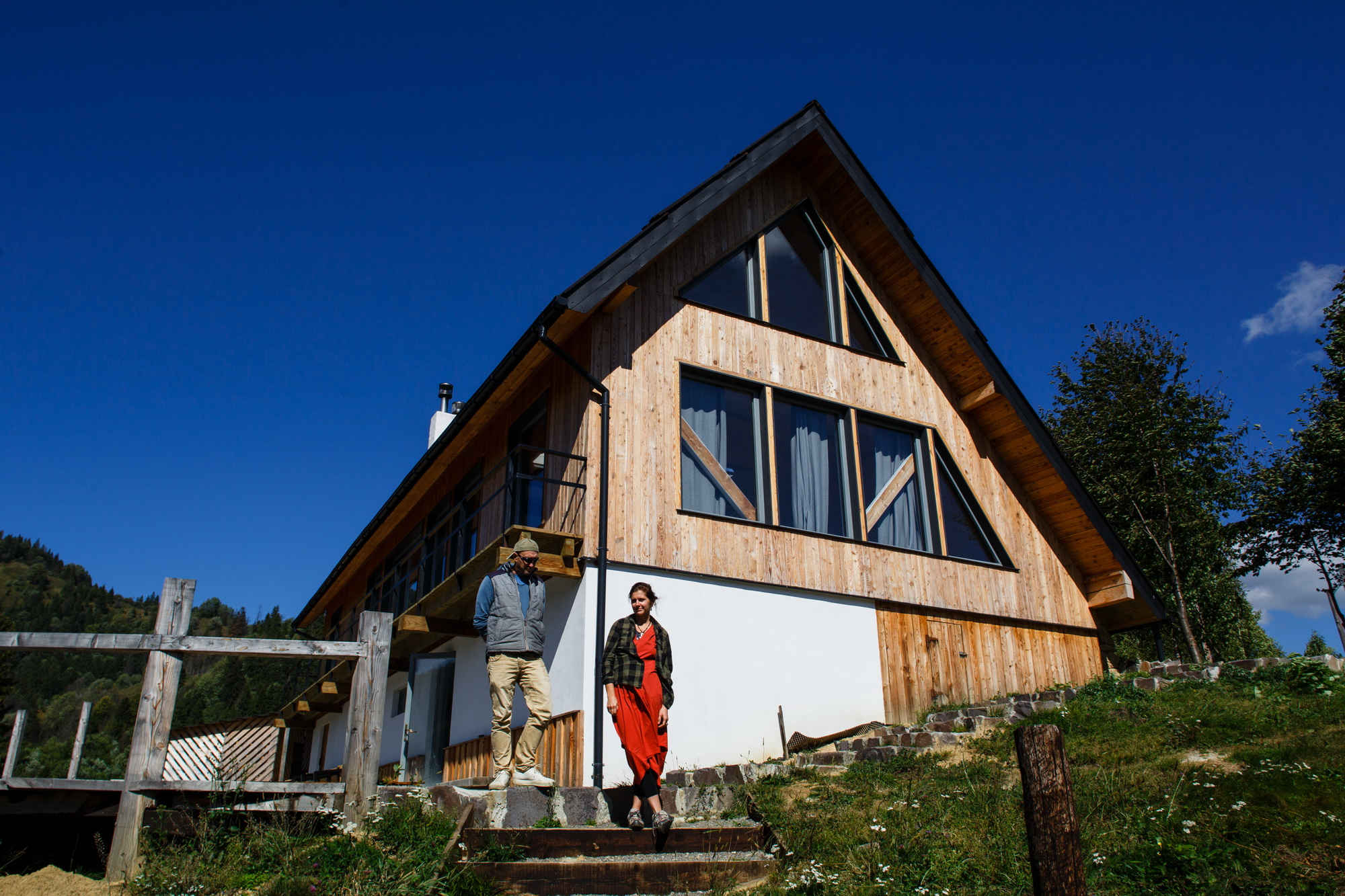
The architects explain that usually people want to build an ecological house for several reasons: worries about personal health, the search for an opportunity to provide their own comfort on an up-to-date basis, and the desire to save resources and reduce waste:
— In fact, an ecological approach combines all of these factors. There are social benefits as well as medical ones. But studies showed that only 13% of people are concerned with the social aspect: is it useful for the Earth? How to reduce energy consumption to minimum? Most people are concerned with their health and comfort.
When dealing with solar collectors and panels, everyone wants to know when they will be repaid. My answer is never. But if you want to feel that you’re making a contribution to reduce the consumption of the Earth’s resources, you’ll be comfortable with the costs. And that means that your costs are paid off. The little things you do — whether you sort the wastes or help an old woman cross the street — these are your ecological actions. I think that’s described in “Depeche Mode” by Serhiy Zhadan. He said that if you follow the rules like brushing your teeth, helping an old woman to cross a street or sharing something with a friend, it would start to work. The same goes for ecology. For example, if you can install solar panels for water heating, that is a social aspect. And if you can build a house where you have comfortable air without air conditioner, that’s the ecological aspect. When you don’t have the smell of particleboard — that’s what we call a feeling of comfort.
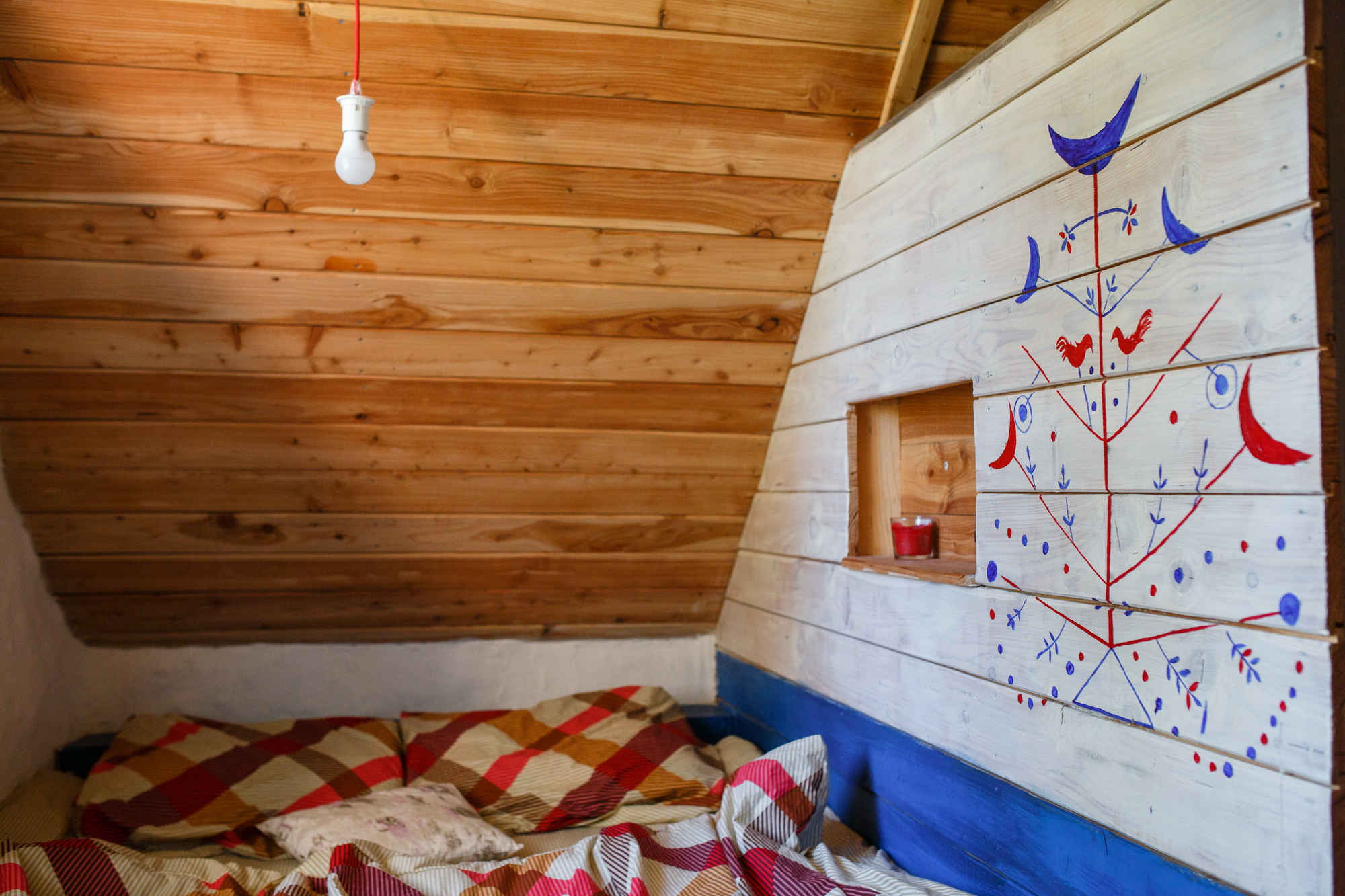
When people feel it necessary, and have the opportunity to build an eco-house, it is often a reflection of their psychological and physical need for changes in their lives:
— When you start to build a house, it is a particular process. When customers come with their outlines for a house, they bring memories and unrealized dreams from their childhood, imposed social norms, positional goods. You need to cooperate on a psychological level to understand which demands are real and which are just imposed by society. For example, when a person feels that there is a lack of communication in their life, they might order a big dining room with a large table instead of simply getting together with friends. They dream of tomorrow and invest in their future. It was very interesting when we followed up on people’s lives while building their houses. When a person gets what they wanted, they don’t feel like they realized their dreams. That is, they have this large table, but there is no crowd of guests to seat, you know? The process of construction is very specific. You should feel responsible: you plan not just how to build the walls; you plan a person’s life and how they will feel in the space.
That’s how the couple define ecology:
— Ecology is all about optimized spaces you live in. It is the ability to appreciate the important and to get rid of the unnecessary. It is an understanding of what you really need.
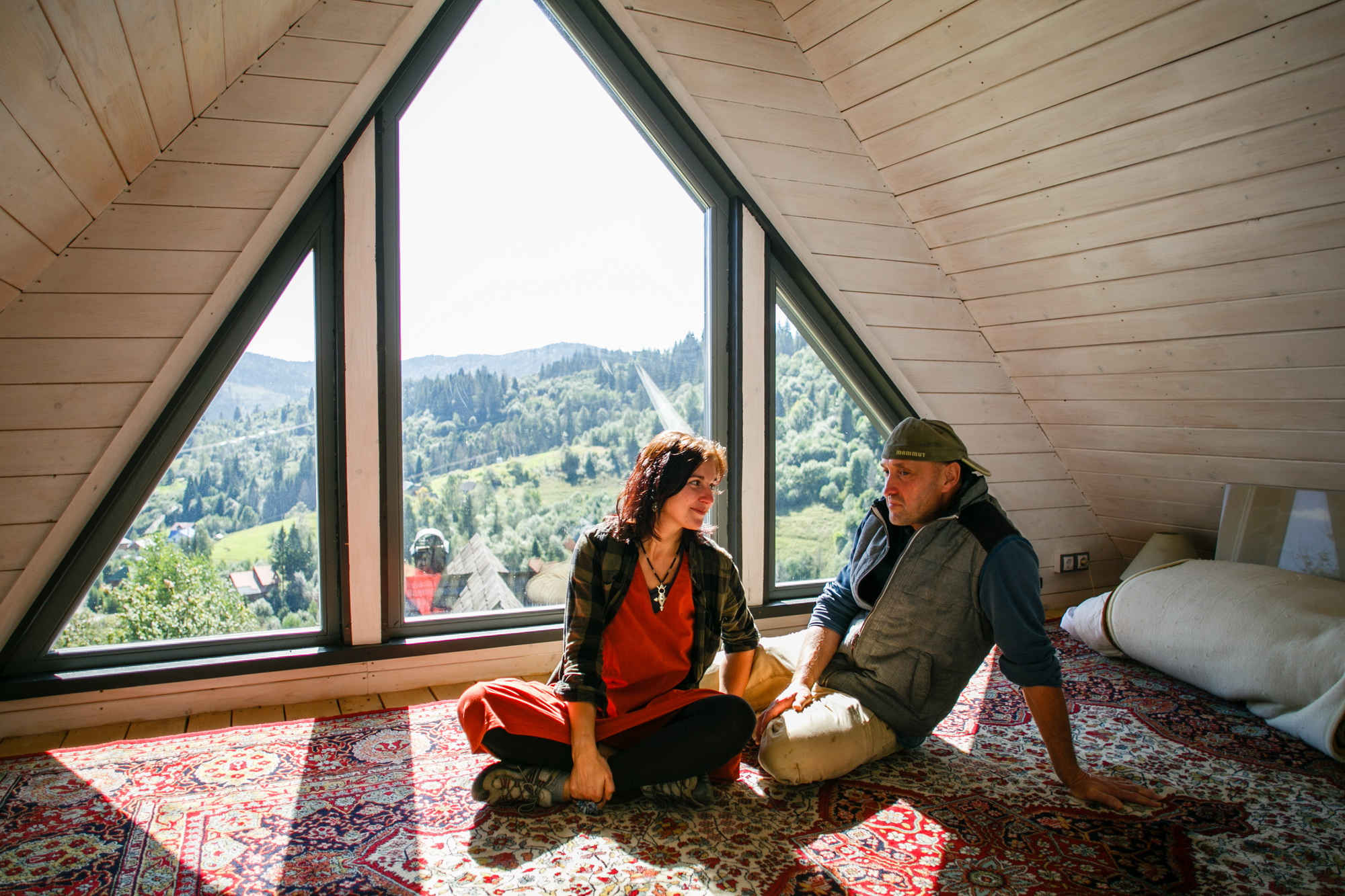
Valuing communication
For the couple, the social component of ecologic projects is very important. Olha and Eduard started to work on various creative programmes, to invite friends and acquaintances to share their experiences and ideas in different areas, from sustainable architecture, ecological technologies and energy restoration, to photography, art and journalistic projects. They insist on the value of communication; they find that some crazy and amazing ideas appear just while sharing. These may become realized eventually, and it’s then that you might find your appraisers and fellow-thinkers:
— It’s like we’re all trying to achieve some state — everyone communicates; our friend, a photographer, told us about his life, how he ended up in photography, what he sees. Somebody else repairs ships, they tell their own stories. Human communication is an extraordinary gift. It is amazing what it can give. Once there was a social survey: people who have lived long lives were asked what they would like to revisit and what they are in need of. They said they spent too little time communicating with their friends. They paid more attention to job and fantasies instead and lived for their future. You should return to basic communication which gives humans an incredible satisfaction. This is where great things are born. We plan to dedicate this space to a synergetic exchange of ideas. You might have a phantasmagoria or idea you think nobody is interested in. But maybe they will be, you know? You can come, communicate, and invent something — together.
Now, theatre groups come to the home and perform their shows. The place has often been host to art therapy sessions, yoga classes and creative workshops. Olha and Eduard are happy to welcome everyone:
— We never have a final goal, we just react to the situation, emotions, and wishes around us. That’s when an initial and clear desire appears, and everything else just fits into the project.
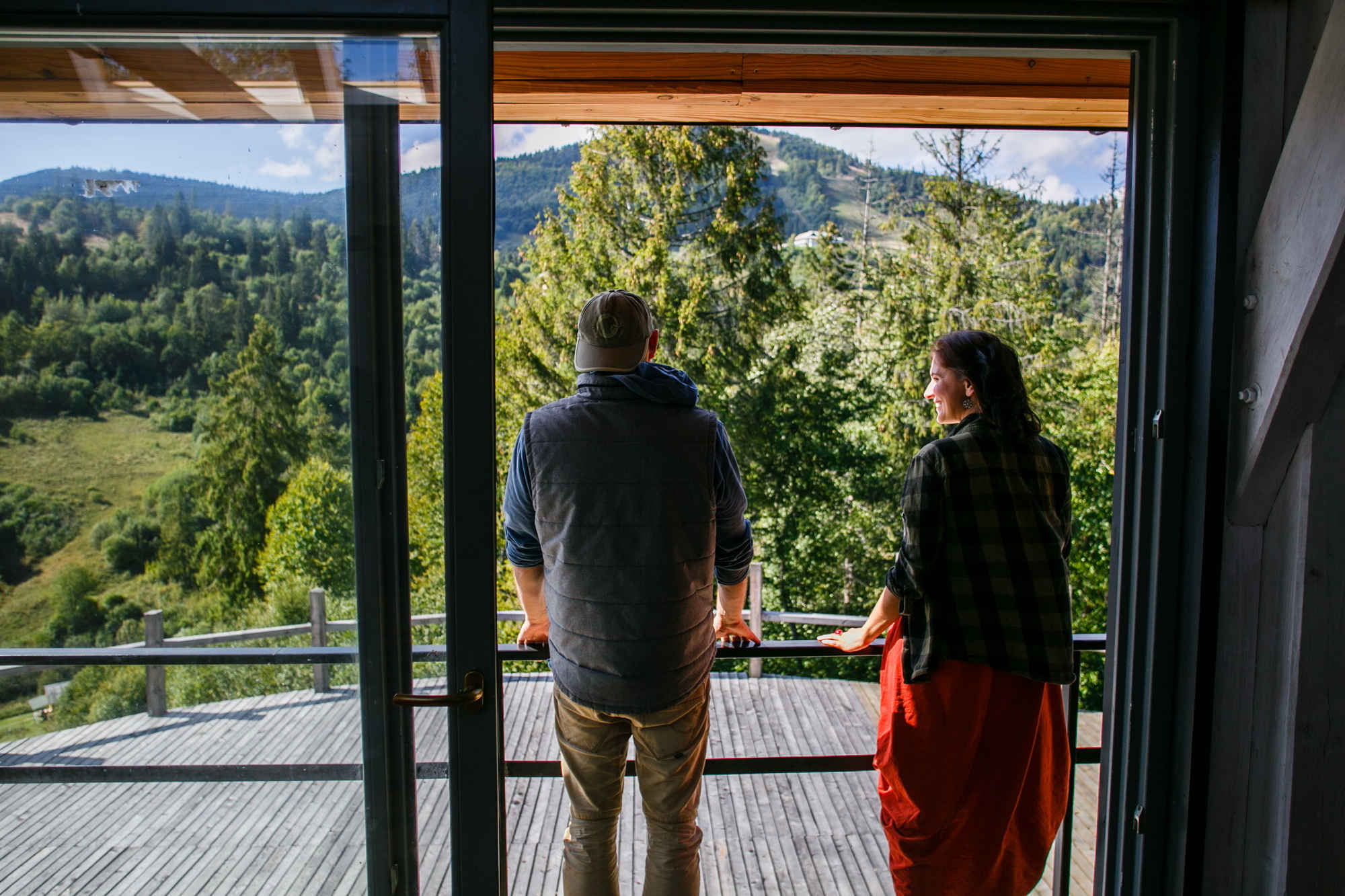
Projects instead of dreams
— I may not use the word “dream” correctly, but for me it feels surreal. There are some things you dream about, but that can’t come true. But we don’t believe in this: we just do these things. It is very important to do what you want with the people you want to work with.
— The feeling of happiness in every moment is probably the biggest accomplishment.
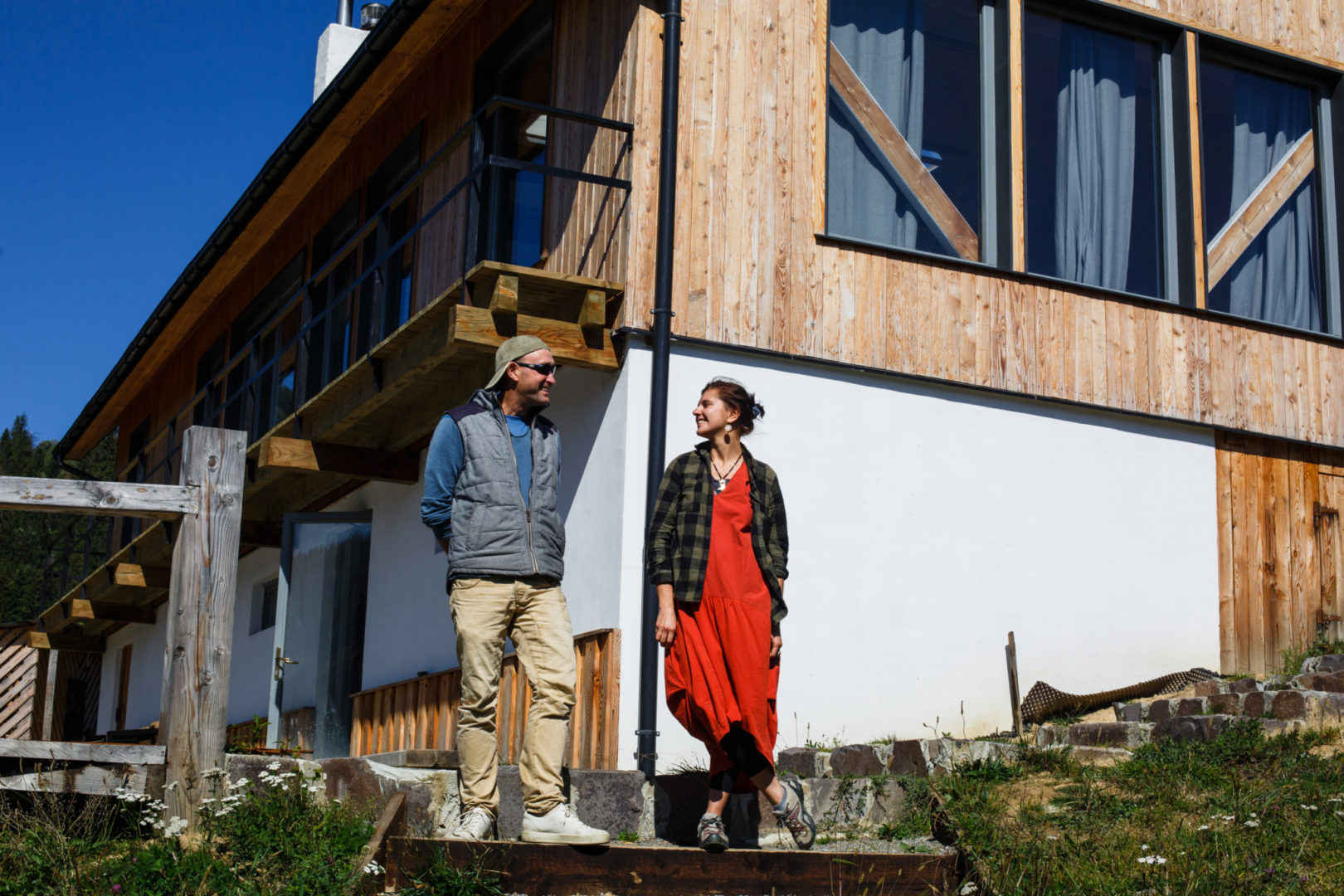
Now an eco-restaurant at the territory of Creative Residence is being built, where there will be master classes with cooks, an opportunity to taste flavours and cuisines from around the world.
— This is a separate kitchen made of brick, there will be a stove to cook on, and there will be a stove for heating on the side. You’ll be able to taste different dishes, invite people here who can cook something interesting and experiment!
Additionally, the architects have come up with an idea to create a unique exhibition on green building achievements. There will be a place for everyone who wants to make sure that eco technologies are expedient and to feel materials themselves:
— We want to build and exploit such things, watch how they perform. So that people who are interested in them could live here, touch, watch and figure out if it fits their lifestyles and is a necessary change.
Coming here, everyone fully understands how these things, such as solar collectors, work, how effective they are in winter, how much heat they generate, and how they compare to traditional energy sources.
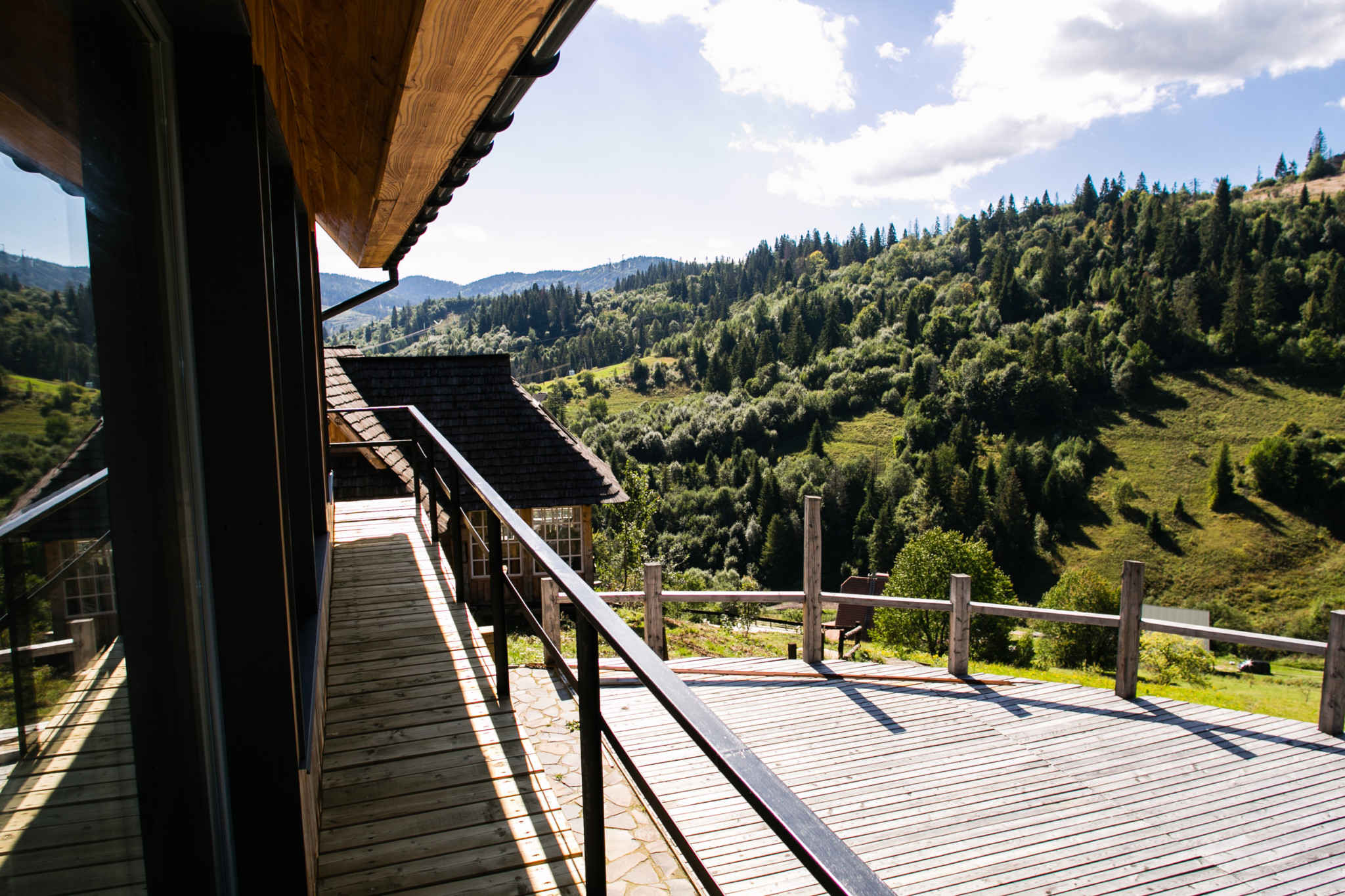
Now, Olha and Eduard are working to build a workshop residence for artists, where they will be able to create, invent, and work. The architects say that they discovered such creative cells for the first time during their travels:
— There are such popular places, buildings where an artist or a writer can spend a month creating something new, and it will result in exhibitions and presentations. That’s what we want to do too. We specifically went to Spain where we found similar places near Barcelona and got acquainted with different kinds of people. One of the residences is maintained by Dutch people, another was built by Norwegians. That’s where the worlds get mixed up.
The future art residence is a place where creative people will meet and combine different artforms.
— It is an intersection of various spheres, the point at which genius things are created. The main goal is to create an atmosphere that encourages people to be creative, so everyone will want to come here.
How we shoot
Watch our vlog to see how we departed from Kyiv, our long journey through Lviv and Morshyn, small guided tours while visiting our partners, and, eventually, our meeting with Olha and Eduard, architects who created their experimental space for green building in Slavske.

